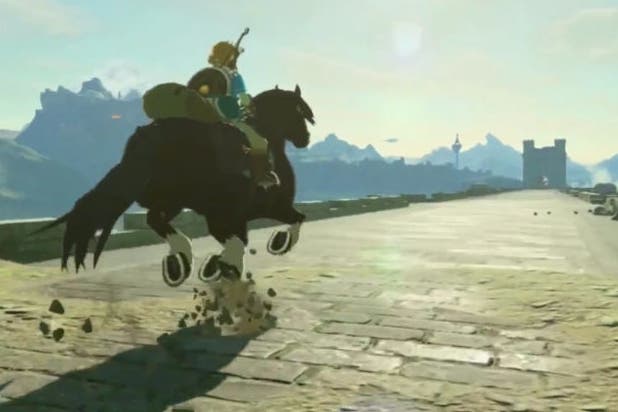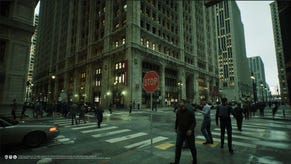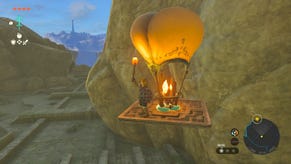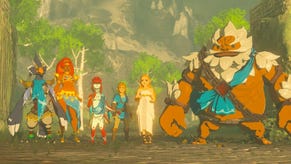Thoughts on three months spent with Zelda: Breath of the Wild
The legend of the legend.
Now here's the thing: The world of Breath of the Wild is one of the most spectacular in a Zelda game yet. Its Hyrule is a recognisable, organic one. All majestic vistas and the just-so undulations of hills and so-true sparkles on running streams and so on. To video game fans, who've grown up bearing witness to the medium's alternate genesis story (Let there be Polygons! Let there be Light Sources and Physics!) digital recreation itself is a celebration. And Breath of the Wild celebrates a lot.
But for all the talk of scale and beauty in Breath of the Wild (and there's lots of both), when played in the hands I think some major changes lie elsewhere, hinted at by Takuhiro Dohta in the first of Nintendo's making-of featurettes.
He mentions the challenge the team had in programming seamless transitions when entering houses, and there've been all sorts of small, granular changes made in the game's commitment to continuous and open exploration. And like a video-cut or line break, I think these little differences completely change the rhythms and feel of its world.
So, whereas this new Hyrule is richer than ever in peaks and troughs and the whole range of landscape ripples in between, Link's unfussy and unrestricted climbing flattens it a little, in a way I couldn't initially put my finger on. In rendering everything equally traversable - like a grip sheet draped over the contours of the world - it certainly gives the game its empowering, free-form, go anywhere, glide-head-on-into-any-wall sense of exploration. But it also subtly changes the binary of older 3D games; of the traversable, and then the unknowable, unreachable rest.
Before, limitations of technology resulted in smaller play spaces, built on the game language of infinite drops and insurmountable, sheer (unclimbable) cliffs. Places like Kokiri Forest were fringed with textures, like theatre set backdrops standing in for 'the rest of the forest'. These were non-literal, abstract renditions of places: built in blocks and borders.
But they were also possibility spaces - like childhood dens - where simplified shorthand can suggest much more. Now, I've written before about how the angular environments of older 3D reflected and enhanced my childhood (read: to this day) explorations of urban environments, all brick-walls and curbed edges. But I also think there was a different effect evoked by these older environments, not beholden to recognisable natural contours, where the interstitial detail between them didn't have to be designed or explained. Those gaming-specific dream spaces of floating deku-plant platforms above pitch-black abysses. Or dungeons that unfolded TARDIS-like within, apparently unconstrained by their outside proportions.
It's not just about geometry and movement, of course. Breath of the Wild is a more jazz-Zelda in general, all flowing, interconnected systems and emergent gameplay. Snatches of half-remembered themes float past as notes on the breeze. Dungeons ground-up into particles and scattered as shrines. The scenery morphing beneath the light and the weather (and the rain and the rain). There are fewer hard transitions.
So you also get fewer fixed enclaves, those single moods stretched and made solid, place-sized and permanent: The old Gerudo Valley, gated by a fade-in screen and forever scored by strings. Or a Tal Tal Heights you left your Gameboy on for, listening to its 8-bit epic on repeat. There's the shrines, I suppose, but they're a bit piece-meal (and often a bit rubbish THERE I SAID IT).
There's also less of the save-and-come-back-trepidation that you'd get at the start of a meaty dungeon in Zeldas old. The whole thing just flows. So accommodating to quick bursts of play - with its sleep mode and portability - that it can rush by in a constant blur of joyous discovery and novelty. The pace feels all different. It made me grateful for the Switch's screenshot button - allowing me to lazily browse my (600-odd) snaps, adding their own retrospective rhythm, parsing the constant, continuous present of play into single moments like memory beats. Much like we do with photos in general, I guess.
I don't mean to sound ungrateful: I loved my time with Breath of the Wild and have waxed lyrical about it as much as the next person (just ask anyone who's come within shouting distance of me since March). But Eiji Aonuma has hinted that Zelda's 3D future is in open-world design, which is all very exciting I know. But I don't think it's simply a realisation of what Zelda always 'could' have been, when all the limitations of what couldn't be done on older consoles resulted in a different kind of Zelda feel, a different shape when taken whole.
I've thought a lot about Breath of the Wild in terms of these internal transitions and rhythms, but also how this affects its borders. The way it tugs at thoughts and ideas outside of the game proper, like a new pop-culture moon in my sky.
So though I've played the game for more than 120-hours now - longer than my actual trips abroad this year, including a Breath of the Real Wild in Canada - it's probably more accurate to say that I've spent 3 months living with Breath of the Wild.
It's fringed my thinking and punctuated my days in sneaky play sessions. It's as irreversibly sewn through my summer as a new favourite album, carried around in my thoughts and lassoed to my days by unexpected associations. Like the rising bleeps of our home phone tone that sounds like the clip-clopping horse theme. Or my sudden enthusiasm for its cookery descriptions during Ramadan. Or one of the most unusual compliments I've ever tried to pay (and I have compliment Tourette's) when I tried to describe a new friend's unselfconscious warmth and optimism as 'like Zelda'. Not the princess, but the series' general sensibility. You get what I mean, at least. You understand - they didn't. Never mind the wildflowers I've been seeing everywhere this year, in a way I hadn't before.
It's possible, I suppose, that it has just been a bumper yield for poppies and cow-parsley. That the bursts of cornflour blue in urban parkland have been extra bright, and the spring blossom foam on roadside hedgerows extra thick. But it's more likely that Breath of the Wild has helped, its rolling Ghibli greens speckled with flowers - like stalks of petal-confetti - rhyming nicely with the spring and (now) summer period it was released in. And more than once I've seen a foxglove from afar and felt the early thrill of spotting a hearty radish plant in Breath of the Wild in an odd bit of pavlovian, cross-world confusion.
But more than just an Oh yeah! recognition, I reckon these associations can multiply the world outside, letting other ones sneak in through its pores . The storybook textures of Skyward Sword's pastel foliage is partly why I can now see how many shades of blue there are in our 'greenery', but it too remains as part of the hue . The floating cotton of poplar tree spores still carry a little of Kokiri forest. The ocarina melodies I still whistle, like souvenirs from another land. Driving to see what's down the other road, pushed by a curiosity cultivated by a video game series of all things, though one with the authority of a classic fable and a reverence for the outdoors and exploration that borders on the moral.
What will my take-home from Breath of the Wild be?
In Robert MacFarlane's fantastic book 'Landmarks', he ends on a chapter called Childish, in which he talks about the way children speak freely and loosely about worlds real and imagined, collapsing the two in their speech and in their mind.
Now, Breath of the Wild doesn't ask you to navigate alternate worlds like in many Zelda adventures. There's no Twilight Realm or Dark World. There's no miniature Minish land or the desolate parallel future of Ocarina. And I'm not sure what it's lasting legacy will be for me, when its details and changes are flattened and compressed by time and perspective. But I know that playing the series whilst growing up has helped keep something intact which I think can often be lost. An ability to see 'childishly', in stereo; with constant, near subconscious exchanges with the lands these games broder; those of past Zeldas, other games but also - especially - our own. Revealing secrets in the gaps, and new ideas where they overlap.




















